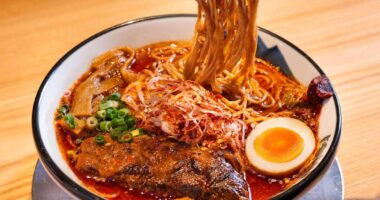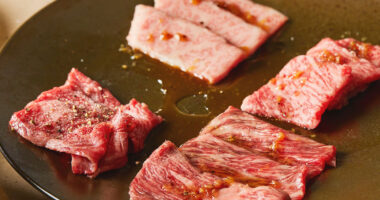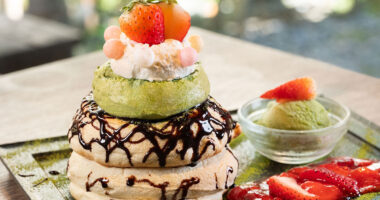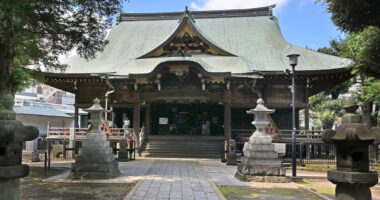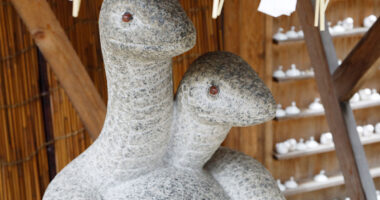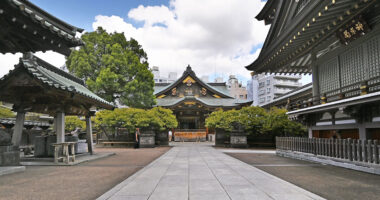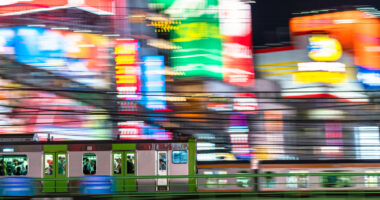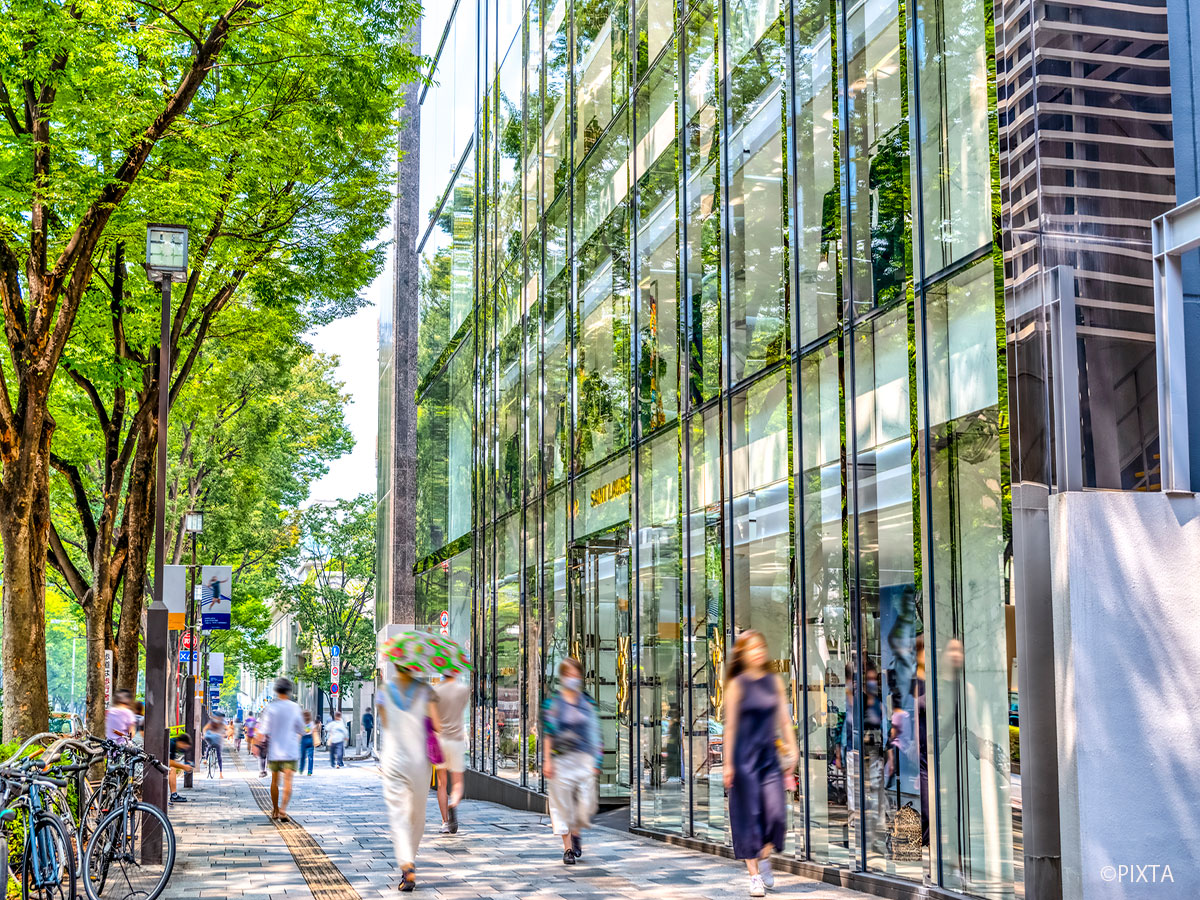Born in Japan and now highly acclaimed in museums around the world, ukiyo-e (traditional Japanese woodblock prints) continue to captivate audiences far and wide.
From the works of Katsushika Hokusai to Utagawa Hiroshige, Tōshūsai Sharaku, and Utagawa Kuniyoshi, masterpieces by these renowned artists are displayed internationally.
Of course, you can also enjoy ukiyo-e in museums right here in Japan. In fact, being the birthplace of ukiyo-e, Japan offers the unique opportunity to encounter rare and specialized works.
In this article, we’ve selected must-visit museums in Tokyo that every ukiyo-e enthusiast should know about.
Step into the world of ukiyo-e—a timeless art form that, even centuries after its creation, continues to fascinate and inspire.
- Harajuku: The Ota Memorial Museum of Art is a must-visit for ukiyo-e fans!
- Ryōgoku: learn the works and history of Katsushika Hokusai at The Sumida Hokusai Museum
- Oshiage: the Tobacco & Salt Museum features truly unique and rare themes
- Nihonbashi: the Ibasen Ukiyo-e Museum is packed with a fascinating private collection
Harajuku: The Ota Memorial Museum of Art is a must-visit for ukiyo-e fans!
Nestled in a quiet corner of Harajuku, this museum is dedicated entirely to ukiyo-e woodblock prints.
The Ota Memorial Museum of Art showcases masterpieces by famed artists such as Katsushika Hokusai, Utagawa Hiroshige, and Kitagawa Utamaro. Its collection spans a wide range of eras, from the Edo period (1603–1868) to the Meiji era (1868–1912), right up to the final years of ukiyo-e.

In addition to mass-produced woodblock prints, the museum also exhibits rare hand-painted ukiyo-e works.
The collection numbers around 15,000 works—impressive in itself. But what makes the museum truly stand out is its dedication to uncovering the lesser-known side of ukiyo-e.
By highlighting under-researched artists and rediscovering works long hidden in the shadows of history, the Ota Memorial Museum of Art offers visitors a deeper, more comprehensive view of ukiyo-e than anywhere else.
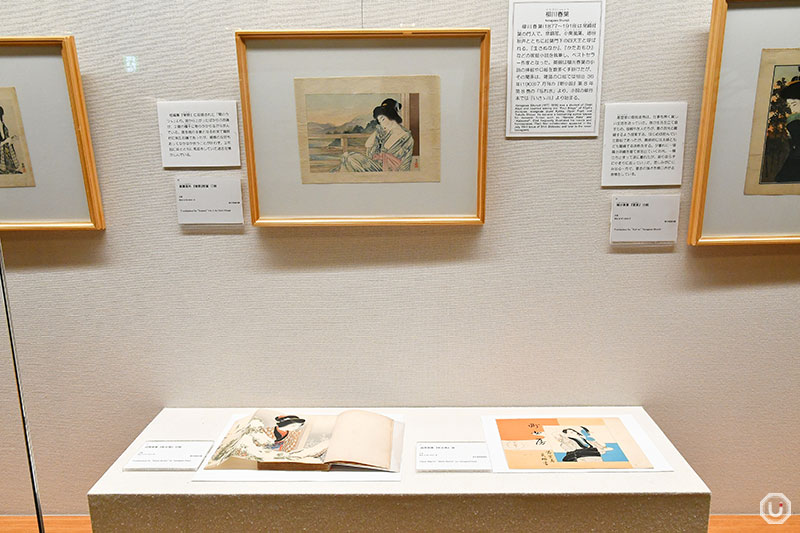
Hirezaki Eihō, featured in a special exhibition in July 2025
For example, the museum’s July 2025 special exhibition highlighted Hirezaki Eihō (1865–1932), an artist active from the late Meiji to the early Showa period.
Though little known today, the exhibition brought fresh attention to his work, offering visitors a new perspective on the richness and diversity of ukiyo-e.
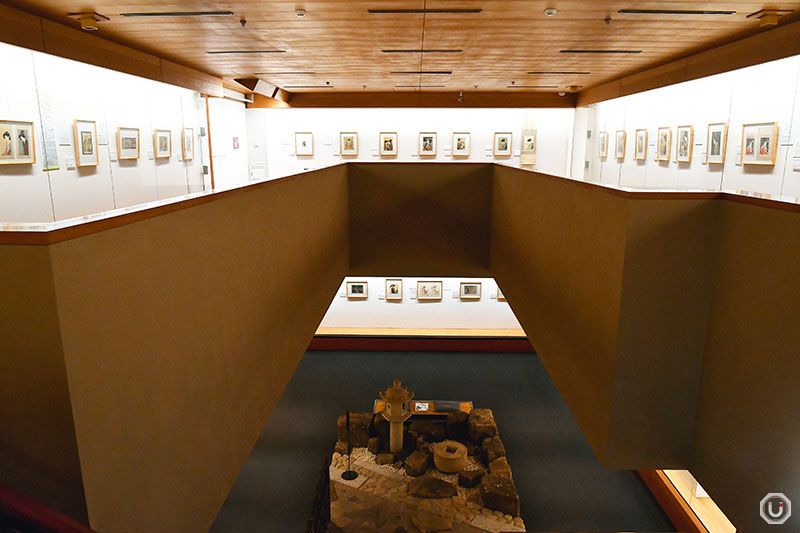
Interior of the Ota Memorial Museum of Art
Exhibitions change every one to several months, each built around a different theme. While classics are always present, many shows spotlight unconventional or innovative angles, ensuring that every visit offers something new to discover.
It’s initiatives like these that continue to inspire and create new generations of ukiyo-e fans.
| Facility name | 太田記念美術館 Ota Memorial Museum of Art |
|---|---|
| Address | 1-10-10 Jingumae, Shibuya-ku, Tokyo
|
| Phone number | 03-3403-0880(”Hello Dial” general information) |
| Hours | 10:30-17:30(last admission is 30 minutes before closing) |
| Closed | Monday(open if Monday is a nat’l holiday; closed the following weekday) unscheduled holidays due to exhibition changes and New Year’s holidays |
| Admission |
General admission varies by exhibition; please check the museum’s official website for details Free for junior high school students (ages 13 to 15); students aged 16 and over must present student ID Elementary school students (ages 6 to 12) or younger must be accompanied by a guardian Disability certificate (includes one companion) / 100 JPY discount (certificate required) ai no-techō (Intellectual disability certificate), ryōiku-techō (Developmental Disability Certificate), Mental disability certificate, and Atomic Bomb Survivor’s Handbook must be confirmed on a case-by-case basis |
| Official website | https://www.ukiyoe-ota-muse.jp/ |
| Pamphlets | None |
| Exhibit audio guides | None |
Ryōgoku: learn the works and history of Katsushika Hokusai at The Sumida Hokusai Museum
Among the ukiyo-e masters celebrated worldwide, few are as renowned as Katsushika Hokusai.
The SUMIDA HOKUSAI MUSEUM (hereafter referred to as “The Sumida Hokusai Museum”), dedicated entirely to his life and work, stands in Tokyo’s Sumida Ward—the very neighborhood where Hokusai was born, raised, and spent most of his career.
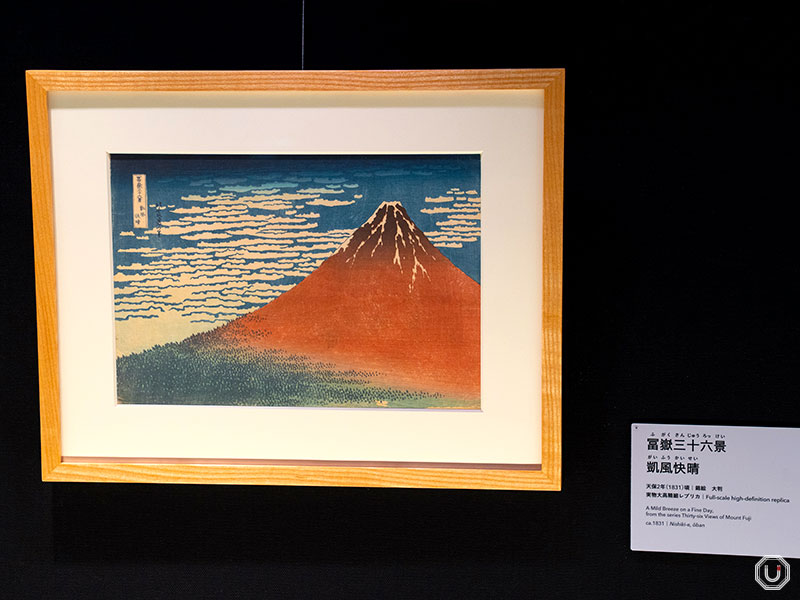
“A Mild Breeze on a Fine Day,” from the series “Thirty-six Views of Mount Fuji”
As expected, the museum’s focus is on Katsushika Hokusai himself. From his iconic “Thirty-six Views of Mount Fuji” series to landscapes, bijin-ga (portraits of beauties), book illustrations, and hand-painted works, the museum showcases the full scope of his extraordinary output across genres.
A must-see for devoted Hokusai fans, the museum is equally appealing to international visitors curious about Japanese art and culture.
Because ukiyo-e is highly sensitive to light and humidity, the permanent collection is displayed using life-size, high-resolution reproductions. These replicas are meticulously crafted to convey the delicate lines and vibrant colors of the originals up close.
At the same time, special and rotating exhibitions occasionally feature genuine prints and paintings, offering lucky visitors the rare chance to encounter Katsushika Hokusai’s original works.
Another highlight of the museum is its blend of tradition and technology. For instance, Katsushika Hokusai’s legendary final masterpiece, “Susano-o no Mikoto Making a Pact with the Spirits of Disease”—thought to have been lost in the Great Kanto Earthquake—has been recreated using surviving black-and-white photographs, traditional restoration methods, and cutting-edge digital technology. The result is nothing short of breathtaking.

Katsushika Hokusai, “Scenery on Both Banks of the Sumida River”
Another highlight is the approximately 7-meter (about 23 feet) long “Scenery on Both Banks of the Sumida River,” displayed in digital format. Visitors can use touch panels to zoom in and compare the scenery of Edo with that of the present day.
It offers an immersive experience, as if walking through the streets of Edo alongside Hokusai himself.
The building was designed by world-renowned architect Kazuyo Sejima, featuring a minimalist and refined design inside and out. Simply being here allows you to spend time surrounded by artistic inspiration.
| Facility name | すみだ北斎美術館 THE SUMIDA HOKUSAI MUSEUM |
|---|---|
| Address | 2-7-2 Kamezawa, Sumida-ku, Tokyo
|
| Phone number | 03-6658-8936 |
| Hours | 9:30-17:30(last admission is 30 minutes before closing) |
| Closed | Monday(open if Monday is a nat’l holiday; closed the following weekday) unscheduled holidays due to exhibition changes and New Year’s holidays |
| Admission |
Admission to the “Education Room—Discover Hokusai—” General admission / 400 JPY (tax included) 300 JPY (tax included) for groups of 20 or more, or for visitors aged 65 and over University & high school students / 300 JPY (tax included) 200 JPY (tax included) for groups of 20 or more Junior high school students and younger / Free Visitors with a disability certificate, ai no-techō (Intellectual disability certificate), ryōiku-techō (Developmental Disability Certificate), Mental disability certificate, or Atomic Bomb Survivor’s Handbook (includes one companion) / Free (certificate required) Admission to Special Exhibitions Varies by exhibition; please check the museum’s official website for details |
| Official website | https://hokusai-museum.jp/ |
| Pamphlets | Available in Japanese, English, Chinese (Simplified & Traditional), Korean, and French language only the museum’s overview brochure |
| Exhibit audio guides | None |
Oshiage: the Tobacco & Salt Museum features truly unique and rare themes
“Tobacco and salt?” The combination might sound a little surprising at first.
But inside the uniquely themed “TOBACCO & SALT MUSEUM,” (referred to hereafter as “Tobacco & Salt Museum”) you’ll find a collection of around 2,000 valuable artworks and documents — including many ukiyo-e prints.
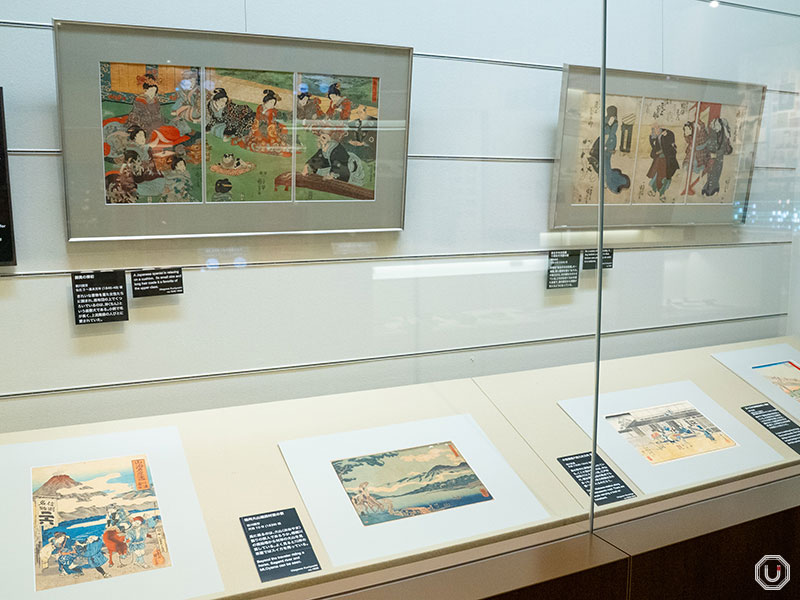
Interior of the Tobacco & Salt Museum
What makes the museum’s ukiyo-e collection especially noteworthy is that it doesn’t focus on just one era or artist — instead, it spans a wide range of styles and themes.
This makes it a rare chance to experience the full diversity of ukiyo-e during the Edo period.
The museum’s focus on ukiyo-e goes beyond their artistic value. Through these prints, visitors can also glimpse everyday life and culture in Edo Japan — especially the ways tobacco became part of daily routines.
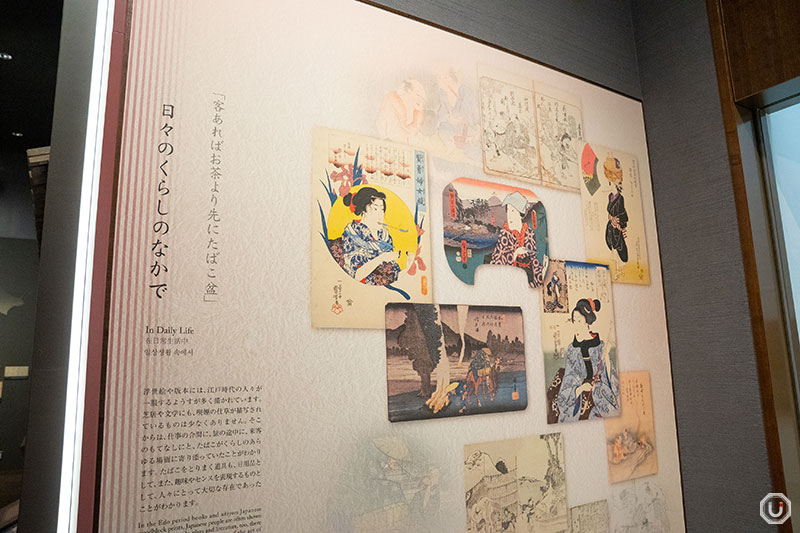
Ukiyo-e prints featuring tobacco offer a glimpse into Edo-period life and culture
Among the museum’s holdings, highlights include “New Year’s Musical Performance at the Inner Palace,” which depicts a noblewoman enjoying the koto (a traditional Japanese stringed instrument) before a tobacco tray.
Another work by Utagawa Kuniyoshi, “View of Tamurabashi on the Ōyama Road in Sagami Province,” depicts travelers enjoying their kiseru (traditional Japanese pipes) along the road.
Additionally, Utagawa Sadahide’s “Contest of Beauties in Floral Patterns” shows courtesans in the Yoshiwara district holding kiseru. Through these characters and scenes, the vibrant tobacco culture of the time comes vividly to life.
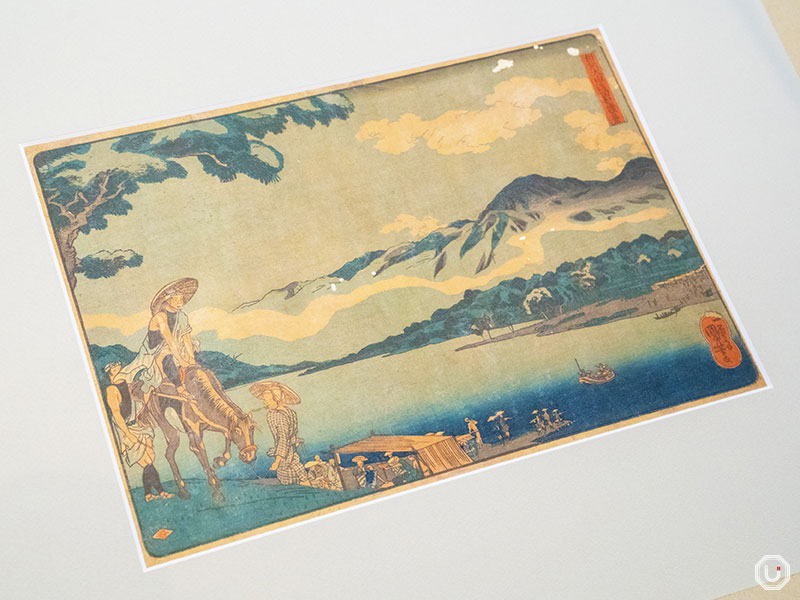
Utagawa Kuniyoshi, “View of Tamurabashi on the Ōyama Road in Sagami Province”
Although the exhibition space at the Tobacco & Salt Museum is compact, it is well-regarded for offering a setting where visitors can take their time and fully appreciate the works on display.
Audio guides and pamphlets are available not only in Japanese but also in English, Chinese, Korean, and Spanish, making it easy for international visitors to enjoy the museum comfortably.
Through ukiyo-e, the Tobacco & Salt Museum provides a vivid glimpse into the daily lives and tastes of Edo-period people, offering a cultural experience that differs from a typical art museum visit.
| Facility name | たばこと塩の博物館 TOBACCO & SALT MUSEUM |
|---|---|
| Address | 1-16-3 Yokogawa, Sumida-ku, Tokyo
|
| Phone number | 03-3622-8801 |
| Hours | 10:00-17:00(last admission is 30 minutes before closing) |
| Closed | Monday (Except when a national holiday falls on Monday. In this case, the museum is open on the holiday and is closed the next day) Unscheduled holidays for maintenance, New Year holidays, and other occasions |
| Admission | General admission 300 JPY (tax included) for groups of 20 or more, an additional 200 JPY (tax included) Ages 65 and over / 100 JPY (tax included) for groups of 20 or more, an additional 50 JPY (tax included) Elementary, middle, and high school students / 100 JPY for groups of 20 or more, an additional 50 JPY (tax included) Free for visitors with a disability certificate (including 1 accompanying person, disability certificate required) |
| Official website | https://www.tabashio.jp/index.html |
| Pamphlets | Available with Japanese, English, Chinese, Korean, and Spanish language museum overview brochure only |
| Exhibit audio guides | Available with Japanese, English, Chinese, Korean, and Spanish language for audio guide rental, a deposit of 1,000 JPY (tax included) is required in cash |
Nihonbashi: the Ibasen Ukiyo-e Museum is packed with a fascinating private collection
Nestled in a quiet corner of Nihonbashi, Tokyo, the Ibasen Ukiyo-e Museum exudes a hidden gem atmosphere. This private museum is operated by Ibasen, a long-established fan and uchiwa (Japanese hand fan) shop founded in 1590.
It’s a special place that connects the merchant culture of Nihonbashi with the world of ukiyo-e, preserving the relationship between commerce and art that has endured since the Edo period.
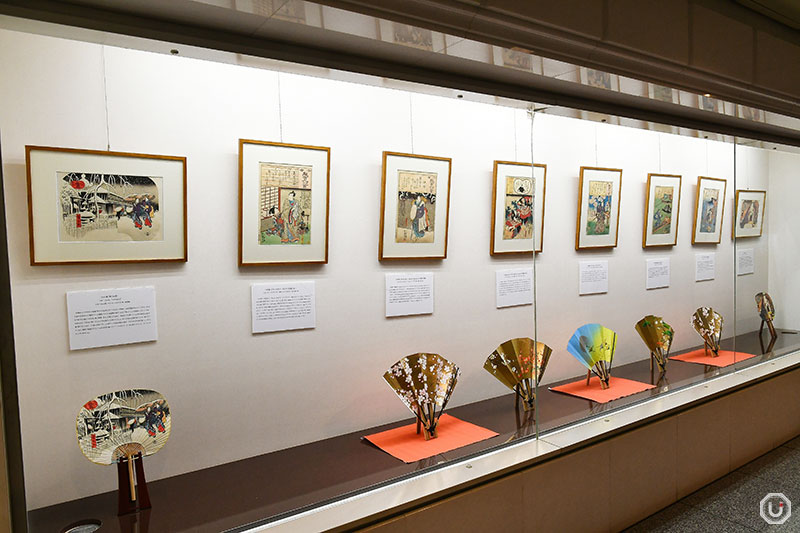
Interior of the Ibasen Ukiyo-e Museum
Ibasen has a long history of using ukiyo-e designs to decorate fans and uchiwa during the Edo period, and later became a hanshi—a publisher that produced and sold ukiyo-e as independent works of art. In other words, they acted much like the producers of Edo-era publications.
As a result, the museum’s collection focuses on works connected to Ibasen, allowing visitors to enjoy a unique blend of Edo publishing culture and refined artistic sensibility.
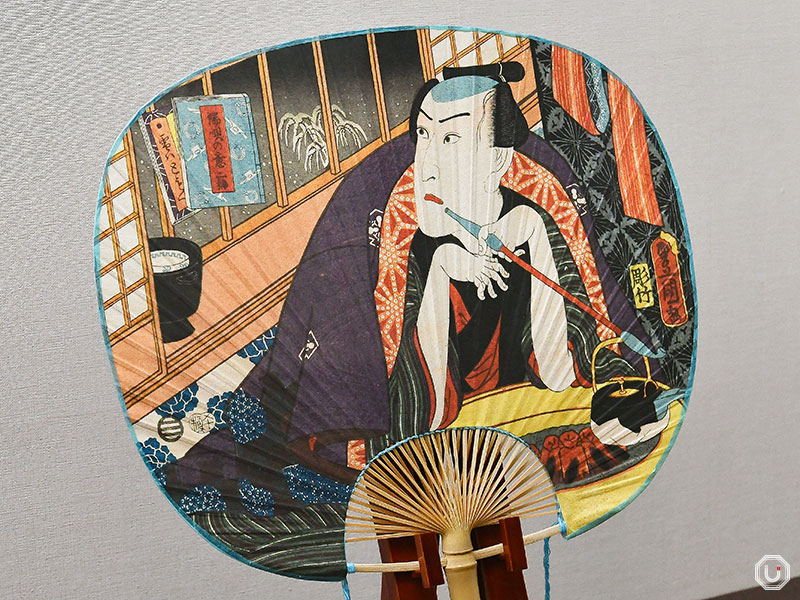
Utagawa Toyokuni, “Uchiwa-e: Anonymous”
The collection features works by renowned artists such as Katsushika Hokusai, Utagawa Hiroshige, and Utagawa Toyokuni.
Among the highlights is the bijin-ga “Ume no Sakigake” (The First Blossoms of Spring) by Utagawa Kuniyoshi.
It depicts three women enjoying plum blossoms during the still-chilly season. It is extremely rare to see this three-part ukiyo-e, which was usually sold as separate prints, preserved together in its complete form.

Utagawa Kuniyoshi, “Ume no Sakigake” (The First Blossoms of Spring)
The museum also displays the actual woodblocks used in creating ukiyo-e. Visitors can closely appreciate the delicate skills of the carvers and printers who brought these prints to life.
These woodblocks survived both the Great Kanto Earthquake and wartime damage, making them extremely valuable historical artifacts. They are not only important as works of art but also hold significant value as cultural heritage.
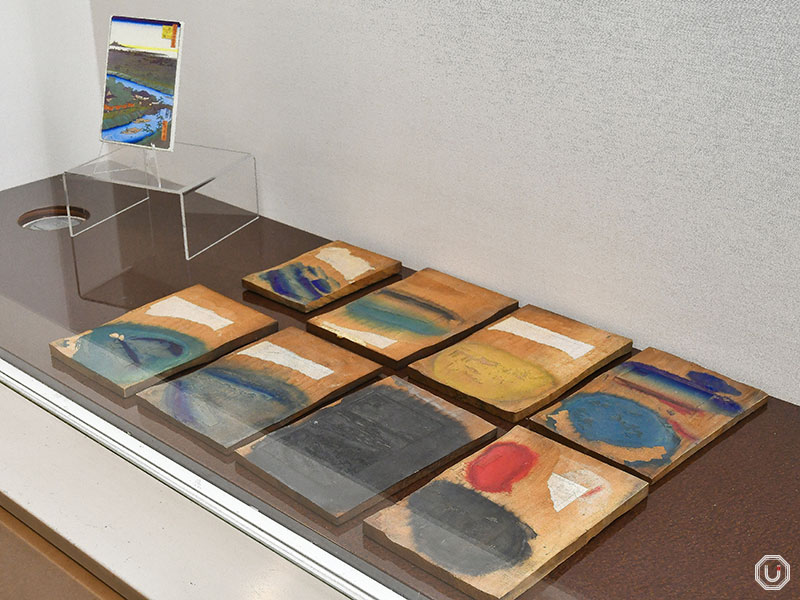
Get an up-close look at these valuable woodblocks
The museum is located alongside the store, so after exploring the exhibits, you can browse and purchase Ibasen fans and ukiyo-e merchandise.
Though small in size, this museum is packed with content and makes a perfect stop while strolling through the streets of Nihonbashi.
| Facility name | 伊場仙浮世絵ミュージアム Ibasen Ukiyo-e Museum |
|---|---|
| Address | 4-1 Nihonbashi-Kobunachō, Chūō-ku, Tokyo
|
| Phone number | 03-3664-9261 |
| Hours | 10:00-18:00 |
| Closed | Sunday and national holidays |
| Admission | Free |
| Official website | https://www.ibasen.co.jp/pages/gallery |
| Pamphlets | Available with Japanese and English language ※only the museum’s overview brochure |
| Exhibit audio guides | None |
From the dynamic compositions of Katsushika Hokusai, the serene landscapes of Utagawa Hiroshige, the humor and satire of Utagawa Kuniyoshi, to the evocative portraits of Tōshūsai Sharaku, ukiyo-e has captured Japanese aesthetics and daily life from the Edo period through Meiji, captivating audiences in museums worldwide.
The five museums introduced here each offer a unique perspective, revealing different facets of the rich world of ukiyo-e. For classic masterpieces, visit the Ota Memorial Museum of Art. To trace the life and artistic journey of Katsushika Hokusai, head to the Sumida Hokusai Museum.
To explore ukiyo-e as part of everyday life, the Tobacco & Salt Museum and the Ibasen Ukiyo-e Museum are must-visits.
The more you learn, the more you’ll appreciate how multifaceted ukiyo-e is and how many rich stories it holds. Embark on your own journey into the world of ukiyo-e.
※All museum information in this article is accurate as of September 2025.

